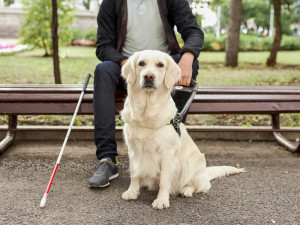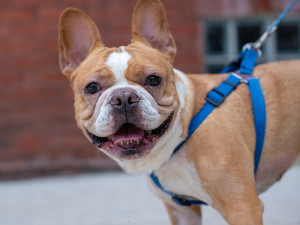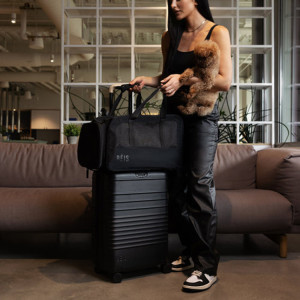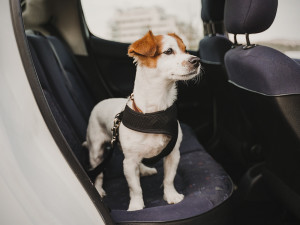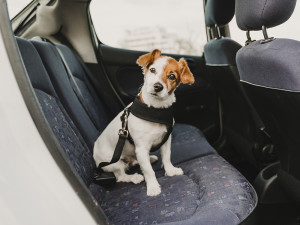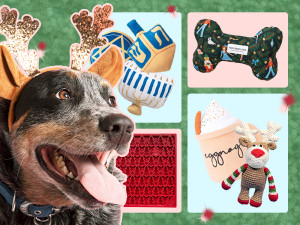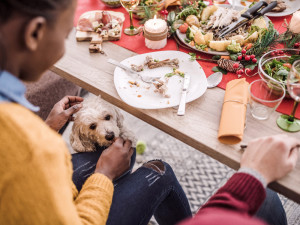All Aboard! How To Take Your Dog On A Train Journey
Heading home for Christmas? Here’s how to help your pup (and you) survive that stressful train journey
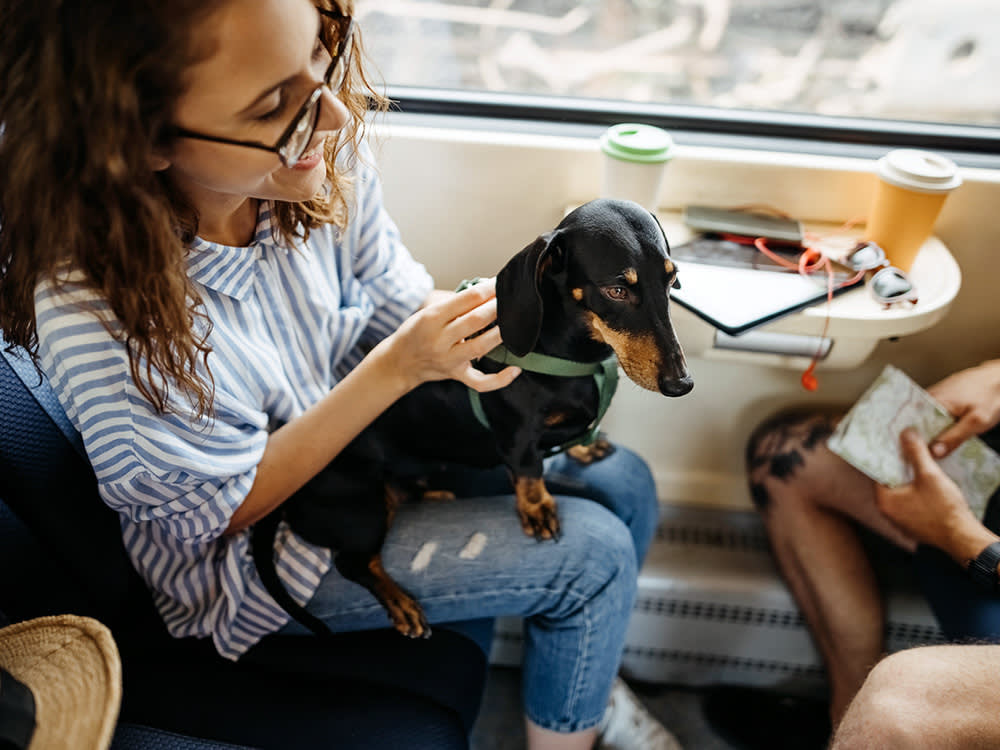
share article
It’s that time of year again when the holiday seasonopens in a new tab is upon us. For many people, that means making the annual pilgrimage home to spend the festive seasonopens in a new tab with their loved ones.
If you, like thousands of others, are planning to take the train back home for Christmas, you might be wondering if you can take your beloved dog along, too. After all, pets are an important part of the family and are part of the festivities just as much as anyone else.
The good news is, yes, you can! But before you embark on your journey, there are some things you should know so you can make the trip smoother trip for both of you.
What National Rail says about dogs on trains
National Rail allows passengers to bring up to two animals at no extra charge, but additional animals may incur a fee. Your dog must be on a leadopens in a new tab or in a pet carrieropens in a new tab while on the train or at stations.
If you use a carrier, it should be rigid and closed to prevent your dog from escaping, and your pup must be able to stand and lie down comfortably inside. Unsurprisingly, dogs are not allowed on seats, but they are permitted on sleeper trains (with an additional charge for a heavy-duty clean).
None of this applies to assistance dogs who always ride for free and are not subject to cleaning charges. Assistance dogs can even join their owners in the restaurant car if there is a suitable table and seat available. Note that regulations may vary slightly between train operators, so it is always best to check with your specific operator before travelling.
To ensure your assistance dog is properly welcomed on board, National Rail offer the Assistance Dog Travel Schemeopens in a new tab, which provides members and their dogs with a card that either slots into the seat reservation holder on top of the seat or can be placed on the cushion on the seat next to yours. The card creates a ‘protected space’ for your dog and lets other customers know the seat and the space under it should be kept free.
Preparing your dog for the train journey
If your dog is well-socialised and generally comfortable around crowds and noise, they may adapt more easily to the bustling train environment.
But if they tend to be anxious or uneasy in such situations, they may find the entire experience extremely stressful. You can help alleviate this with careful preparation, such as gradually exposing your dog to as many stimuli as possible well in advance and making sure it is a positive experience.
For example, if you have access to a railway station, take your dog for walks in the area to get them more accustomed to all the hustle and bustle, sounds and smells. Pair the experience with lots of high-value treats. In other words, something irresistible and delicious that your dog doesn't normally get, like chunks of cheese or hot dog. Every time you hear a train, give your dog treats until it has gone past. If possible, walk your dog along a quiet part of the platform and reward them for that, too.
You might even be able to practice getting on and off a train with your pup, without actually going anywhere. This will all help create positive associations with trains and train stations in general, which can help alleviate some of the stress when it comes to travel day. If you don’t have direct access to a train station, you can always play an audio track of a train at home and pair it with those same high-value treats. Even the smallest preparations you make in advance can help your dog cope better on the day of your journey, so it’s well worth investing the time.
It is also important to make sure your dog responds reliably to basic cues, such as ‘sit’, ‘wait’ and ‘down’ as this will help ensure their safety and the comfort of those around them.
Tips for travelling with your dog on a train
Book in advance
Make sure you book your ticket in advance to avoid any issues on the day of travel. Try to book your travel at a quieter time of day when the trains will be less busy.
Choose the right seat
If possible, opt for a seat near the door or in an aisle seat so that you have easy access to take your dog into the corridor for a break, if needed.
Pack essentials
Bring everything your dog needs for the journey, including water, a portable bowl, waste bags, wipes, snacks and treats. It’s also good to have a favourite toyopens in a new tab and a familiar blanketopens in a new tab to help keep them calm during the journey.
The train will be full of unfamiliar scents, so something that has your dog’s own scent can be enormously comforting. A non-slip mat is another good option as some trains may have shiny or slippery floors that can be scary for dogs.
Get the right gear
If your dog is small enough to travel in a carrier, make sure they are comfortable with being confined in it well in advance of travel day. For larger dogs, invest in a sturdy and secure harnessopens in a new tab and leash to keep them safe during the journey.
Sometimes, when dogs feel like they cannot escape a scary situation, they may barkopens in a new tab or lunge at people to try to protect themselves. If this is likely to be your dog, consider conditioning him to wear a basket muzzle for the journey, just to make doubly sure everyone stays safe.
Bring calming aids
You might want to consider using calming aidsopens in a new tab such as pheromone sprays or natural supplements to help keep your dog relaxed during the journey. These can be purchased at most pet shops and are worth trying out before the trip to see if they have a positive effect.
Take care when boarding
Be careful (and patient) when getting on your train as there may be a gap between the train and the platform that dogs may be wary of stepping over. The same applies to any steps and narrow doorways.
Be aware of stressors
Dogs are often uncomfortable in situations where they have no control over their environment. In many ways, a train journey is a perfect storm: crowds of people, people talking loudly, unfamiliar people, unfamiliar scents, the noise of the train, the rocking motion of the train, being confined for an extended period, and the close proximity of all those strange people and, possibly, other pets, too.
Watch for signs of stress
Dogs tell us how they are feeling with their body language. If you see signs of stress, like pinned-back earsopens in a new tab, a tucked tail, a hunched posture, whites of the eyes showing, drooling, panting, or yawning, know that your dog is probably feeling anxious and take measures to help them relax.
Some dogs will express their stress vocally and may whine or bark excessively. If this is the case, try not to make the situation even more stressful by scolding your dog. Instead, try to calm him down and maybe take a little walk out into the corridor or to a less populated part of the train so they can have a break.
Keep your dog calm
Stay in physical contact with your dog, speak to them in a soothing tone, and offer treats or rewards for calm behaviour. Be aware though that if they are scared or stressed, they may not respond or take the treats. A chew toyopens in a new tab is a good alternative as chewing helps dogs relax and gives them something to focus on.
Like children, dogs use their owners as a secure base and look to them for guidance in challenging situations. If you remain calm and your dog is able to maintain physical contact by leaning against you, it can go a long way towards alleviating their feelings of stress and anxiety.
Toilet training
Before you start your journey, make sure your dog has been for a nice walk as this will help them feel more relaxed. Just before boarding the train, make sure they have one last chance to relieve themselves.
Just like humans, dogs can get motion sickness, so you may want to consult your vet about whether you should limit your dog’s food and water intake for a few hours beforehand. Stress can also cause gastrointestinal upsets, so this is something else to be aware of. Either way, make sure your dog stays hydrated and that you regularly offer them water during the journey.
If, despite your best efforts, your dog has an accident, try not to stress out or get angry. Simply stay calm and do your best to clean it up with your wipes and waste bags without making a big deal out of it. If you get cross with your dog, it will only add to their stress levels, which is the last thing you want.
Respect others
Hard though it is to believe, not everyone loves dogs as much as we do! Train your dog in advance to sit or lie quietly at your side and not jump on or bother other passengers. This is where your scented blanket or mat will come in handy. If your dog gets restless, head out into the corridor so they can stretch their legs and have a little break.
Be mindful of luggage
I can’t tell you how many times I’ve seen a dog being knocked in the face with someone’s bag! Try to remember that your dog’s eyeline is a lot lower than yours and that other passengers may not always see your dog. Keep your dog close to you and away from other people’s luggage to avoid any potential accidents or additional stressors.
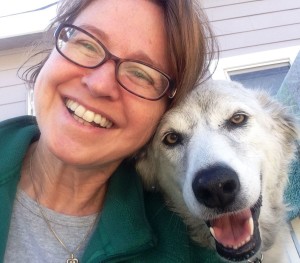
Susan Nilson
Susan Nilson is an accredited cat and dog training and behaviour professional. A long-term adopter of fearful rescue animals, in 2022 she founded The Cat And Dog Houseopens in a new tab, an authority website geared toward helping pet parents better understand their cats and dogs.
Related articles
![A woman standing next to a suitcase with a dog carrier on top while holding her dog.]() opens in a new tab
opens in a new tabThe Best Dog Carriers For Planes, Trains and Automobiles
Whether you’re driving across the UK or flying internationally, your pup can comfortably tag along
![Jack Russell dog in backseat of s car wearing a safety harness and seat belt]() opens in a new tab
opens in a new tabHow to Keep Your Dog Safe in the Car
Hitting the road with your dog? Make sure they’re safe with this helpful advice
![Dog seat-belted in a car]() opens in a new tab
opens in a new tabThe Best Car Travel Gear for Dogs
All the essentials you need to hit the road with your copilot, from pet seatbelts to dog goggles
![grey whippet in green fluffy jumper on a pink box]() opens in a new tab
opens in a new tab10 Cute Christmas Jumpers Just For Dogs
Get your pup in the festive spirit
![collage by the wildest creative team]() opens in a new tab
opens in a new tab8 Christmas-Themed Toys Your Dog Will Sniff Out as Soon as You Wrap Them
No dog can resist a ‘Pawlity Street‘ squeaker toy
- opens in a new tab
Can Dogs Eat Turkey?
Before you invite them to Christmas dinner, here’s what you should know
![dog hiding under christmas dinner table eating scraps]() opens in a new tab
opens in a new tabWhich Christmas Foods Can My Dog Eat?
From turkey to mince pies, Brussels sprouts to parsnips, find out which festive foods it’s safe to sneak your pup from the table

